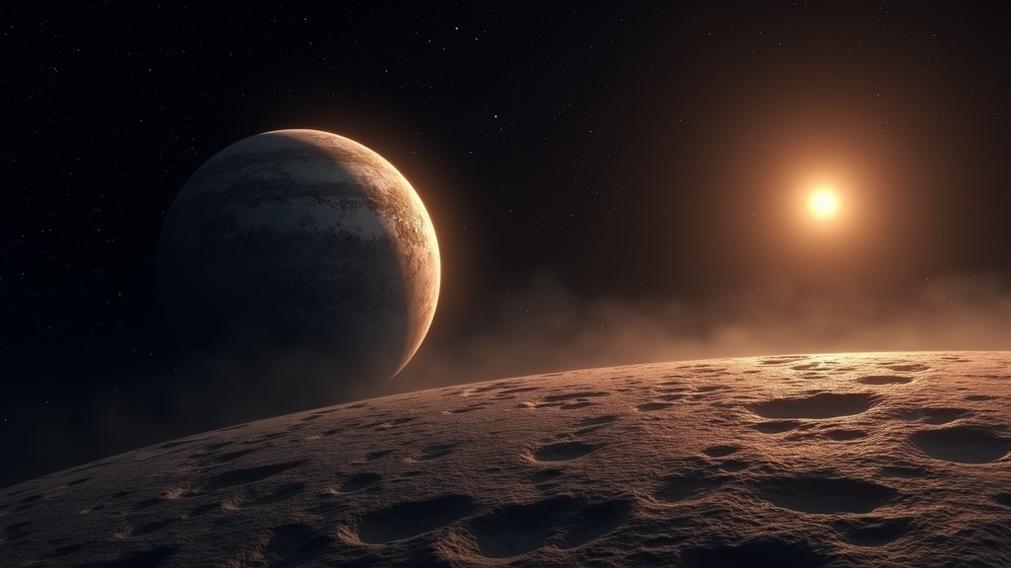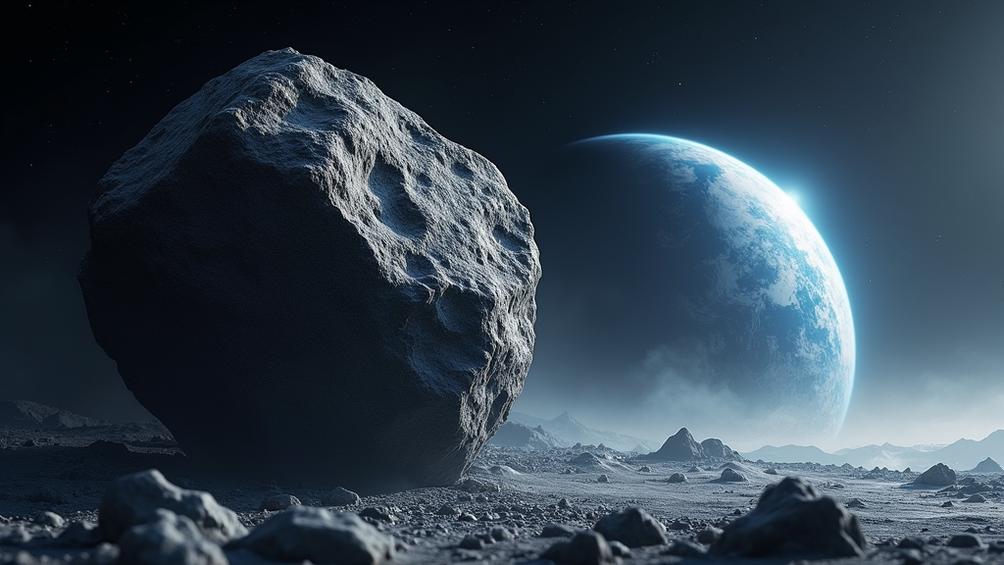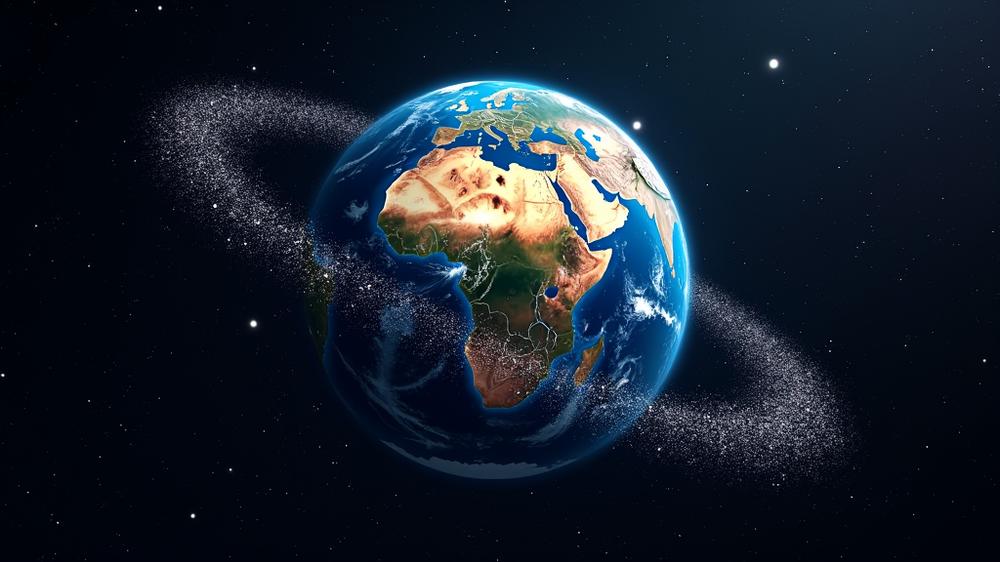Natural Satellite: Definition, Difference, Largest, Planets
Natural satellites are celestial bodies orbiting larger astronomical objects in space. Planets, dwarf planets, and smaller bodies can have natural satellites, commonly referred to as moons. Earth’s Moon orbits at an average distance of 384,400 kilometers from our planet. Jupiter has 79 known natural satellites, while Mercury has none.
Saturn holds the record for the most natural satellites with 146 moons. Jupiter follows with 92 confirmed moons. Uranus has 27, Neptune 14, Mars 2, and Earth 1. Venus and Mercury have no natural satellites.
Earth possesses one natural satellite called the Moon. The Moon orbits Earth at an average distance of 238,855 miles (384,400 kilometers). Moon formation occurred 4.5 billion years ago, possibly resulting from a collision between Earth and a Mars-sized object named Theia.
Ganymede is the largest natural satellite in the solar system. Ganymede orbits Jupiter and surpasses even the planet Mercury in size. The moon has a mean diameter of 5,268.2 km and an equatorial diameter of 5,262 km. Ganymede’s mass is 1.4819 x 10^23 kg, with a surface area of 1.936 x 10^10 km² and a volume of 7.1 x 10^10 km³.
What is a natural satellite?
Natural satellite is a celestial body that orbits around a larger astronomical object in space. Planets, dwarf planets, and smaller bodies can all be natural satellites. Astronomers commonly refer to natural satellites as moons, distinguishing them from artificial man-made satellites. Earth’s Moon orbits at an average distance of 384,400 kilometers, providing scientists with valuable insights into planetary formation and evolution. Jupiter, the largest planet in our solar system, has 79 known natural satellites, while Mercury has none.
Natural satellite examples include Earth’s Moon, Mars’ Phobos and Deimos, and Jupiter’s and Saturn’s moons. Jupiter possesses 79 known moons, while Saturn has 62 confirmed natural satellites. Most planets in our solar system have natural satellites, with Mercury and Venus being the exceptions. The Moon represents Earth’s only natural satellite, orbiting at an average distance of 384,400 kilometers.
Natural satellite orbits form elliptical shapes due to gravitational interactions. The Moon completes one Earth orbit in 27.3 days. Retrograde orbits move opposite to planetary rotation, as seen with Neptune’s moon Triton. Natural satellite gravity plays a crucial role in maintaining these orbits and influencing the parent body. The Moon’s gravity equals one-sixth of Earth’s gravity and causes ocean tides on our planet.
Natural satellites vary in size and composition. The Moon’s diameter spans 3,475 kilometers. Jupiter’s largest moons, known as the Galilean moons, include Io, Europa, Ganymede, and Callisto. Saturn’s moon Titan and Neptune’s moon Triton exemplify large natural satellites with significant atmospheres. Natural satellites range from small, irregular bodies to large, planet-like objects. The mass and radius of a natural satellite determine its gravitational influence on the parent body and surrounding environment.
What is the difference between planet and satellite?
Planets orbit stars like the Sun, while satellites revolve around larger bodies like planets or moons. Planets have cleared their orbital neighborhood and possess atmospheres. Satellites lack sufficient mass to clear their orbits and lack atmospheres. Earth, Mars, and Jupiter exemplify planets. The Moon, International Space Station, and Hubble Space Telescope exemplify satellites. Natural satellites include moons, while artificial satellites include human-made spacecraft.
Planets do not emit their own light through nuclear reactions but reflect the light of their parent star. Some satellites reflect the light of their parent planet or star, making them visible from Earth. Planets belong to a single category of celestial bodies, while satellites divide into natural and artificial types. Natural satellites form in orbit around a planet as moons, and artificial satellites are launched into orbit by humans.
The distance from Earth to planets exceeds the distance to satellites. Venus, the closest planet to Earth, averages a distance of 25 million miles, while many natural satellites, like the Moon, maintain closer proximity to Earth. The speed of satellites surpasses the speed of planets. The Moon orbits Earth at a speed of 2,160 miles per hour, while Earth orbits the Sun at a speed of 67,000 miles per hour.
Planets must meet specific criteria for classification. These include orbiting a star, having sufficient mass for hydrostatic equilibrium, and clearing their orbital neighborhood. Satellites orbit larger bodies like planets or dwarf planets and do not meet the criteria for planet status in their definition.
Which planet has the largest number of natural satellites?
Saturn holds the record for the largest number of natural satellites in the solar system with 146 moons. Jupiter follows with 92 confirmed moons. Uranus has 27, Neptune 14, Mars 2, and Earth 1. Venus and Mercury have no natural satellites. Recent discoveries continue to update these numbers.
Jupiter’s size and gravitational pull contribute to its ability to capture and retain moons. The Galilean moons – Ganymede, Callisto, Io, and Europa – are among Jupiter’s most famous satellites, discovered by Galileo Galilei in 1610. Ganymede, the largest moon in the solar system, surpasses even the planet Mercury in size with a diameter of 5,262 kilometers.
Which planet has no natural satellite?
Mercury and Venus lack natural satellites in our solar system. Solar proximity prevented satellite formation or capture around these inner planets. Intense solar radiation and strong solar winds stripped away potential moon-forming material during early solar system development. Earth possesses one moon. Mars has two moons: Phobos and Deimos. Other planets have multiple natural satellites.

Venus is called Earth’s twin due to its size and mass. Venus orbits the Sun at an average distance of 108 million kilometers. Venus’ retrograde rotation, spinning in the opposite direction of most planets, contributes to its inability to retain moons. Strong gravitational influences from the Sun and other planets further hinder Venus’ capacity to capture natural satellites. Venus may have had a moon in the past, but it was likely destroyed or ejected from orbit due to these gravitational interactions.
How many natural satellites does the Earth have?
Earth possesses one natural satellite called the Moon. The Moon orbits Earth at an average distance of 238,855 miles (384,400 kilometers). Moon formation occurred 4.5 billion years ago, possibly resulting from a collision between Earth and a Mars-sized object named Theia. Earth has no other confirmed natural satellites besides the Moon.

How many artificial satellites does Earth have?
Earth orbits 8,261 artificial objects in outer space. European Space Agency reports this figure for 2023. Total includes active and inactive satellites, along with other man-made objects. United Nations Office for Outer Space Affairs counts 5,465 active satellites as of January 1, 2023. Satellite numbers continue growing steadily over time.
Earth’s satellite population has grown in recent years. On January 1, 2021, Earth had 6,542 artificial satellites in orbit. By September 1, 2021, the number decreased to 4,550 satellites. According to UNOOSA, 8,261 artificial satellites orbited Earth as of April 2022. As of April 30, 2022, there were 5,465 active satellites, with 3,433 belonging to the United States.

Hypothetical scenarios predict up to 1 trillion objects could orbit Earth in the future. Earth’s orbit accommodates an ever-increasing number of artificial objects as space agencies and private companies continue to launch new satellites.
What is an artificial satellite?
Artificial satellites are human-made objects orbiting celestial bodies. Spacecraft placed in orbit around Earth or other planets serve diverse purposes. Communication relay, weather forecasting, navigation, broadcasting, and scientific research are primary uses. Sputnik 1, launched by the Soviet Union in 1957, was the first artificial satellite. Satellites orbit at various altitudes, from 160-36,000 km, depending on their function.
The mass of artificial satellites varies based on their purpose and design, ranging from a few kilograms to several tons. Artificial satellites circle larger objects while moving under the influence of gravity. Engineers design artificial satellites with specific components for their intended missions. Artificial satellite drawings depict spacecraft with solar panels, antennas, and sensors.
Artificial satellites are needed for modern communication technology to function. Communication satellites enable global telecommunications networks. Weather forecasting satellites collect atmospheric data for meteorological predictions. Navigation satellites provide timing and location information for GPS systems. Broadcasting satellites transmit television and radio signals worldwide. Scientific research satellites gather data on Earth’s climate, environment, and space phenomena.
What is the difference between natural and artificial satellites?
Natural satellites form through space processes, orbiting celestial bodies. The Moon exemplifies Earth’s natural satellite. Artificial satellites are human-made objects launched into orbit. Over 5,400 active artificial satellites orbit Earth as of 2022. Artificial satellites enable global communication, weather forecasting, and scientific research. Natural satellites provide insights into solar system formation and evolution.
Natural satellites orbit their parent bodies and influence tides and rotation. The Moon, for example, affects Earth’s tides and stabilizes its axial tilt. Natural satellites form through astrophysical processes of capture, co-formation, or collision. Examples of natural satellites include Earth’s Moon, Mars’ moons Phobos and Deimos, and Jupiter’s moon Europa.
Artificial satellites are human-made objects launched into space. These satellites are designed, manufactured, and deployed by humans for specific purposes. Humans control artificial satellites through ground stations or onboard systems. Commands are sent to adjust their orbits, orientation, and functions as needed. Artificial satellites have limited lifespans ranging from years to decades. Their operational life depends on factors such as fuel supply, solar panel degradation, and exposure to space debris.
Artificial satellites serve human purposes like communication and research. GPS satellites provide global navigation services, while weather satellites monitor atmospheric conditions. Humans manufacture artificial satellites on Earth and launch them into space. These satellites are precisely engineered to withstand the harsh conditions of space and perform their intended functions. Examples of artificial satellites include the International Space Station, Hubble Space Telescope, and communication satellites in geostationary orbit.
What is the largest natural satellite in the solar system?
Ganymede is the largest natural satellite in the solar system. The moon orbits Jupiter and surpasses even the planet Mercury in size. Ganymede boasts impressive dimensions, with a mean diameter of 5,268.2 km and an equatorial diameter of 5,262 km. The moon’s polar diameter measures 4,879 km, contributing to its overall spherical shape. Ganymede’s mass is substantial at 1.4819 x 10^23 kg, while its surface area spans 1.936 x 10^10 km². The moon’s volume reaches 7.1 x 10^10 km³, making it a truly massive celestial body.
Ganymede’s composition consists of water ice and rock. A subsurface ocean lies beneath the moon’s frozen exterior, containing more water than all of Earth’s oceans combined. Ganymede possesses its own magnetic field, a unique feature among moons in our solar system. The moon lacks a substantial atmosphere, presenting a stark contrast to its internal complexity.
What are the natural satellites of Mars?
Mars has two natural satellites: Phobos and Deimos. Phobos orbits at 6,000 km altitude, completing one orbit in 7 hours 39 minutes. Deimos orbits at 20,000 km, taking 30 hours per orbit. Astronomer Asaph Hall discovered Deimos on August 12, 1877 and Phobos on August 18, 1877. Both moons are irregularly shaped and composed of carbonaceous chondrite material.
Phobos is tidally locked to Mars, always presenting the same face to the planet. Phobos has an irregular shape and completes one orbit around Mars in 7 hours and 39 minutes. Phobos appears to rise in the west and set in the east on Mars due to its rapid orbit. Deimos has a more regular shape compared to Phobos and takes 30 hours to complete one orbit around Mars. Deimos is tidally locked to Mars.
Mars orbits the Sun at a distance of 225 million kilometers, completing one orbit in 687 Earth days. Mars appears to have two tiny, misshapen moons due to its weak gravitational pull. Scientists debate the origin of Phobos and Deimos, with some theorizing they are captured asteroids while others suggest they are remains of a larger moon.
How many natural satellites does Jupiter have?
Jupiter officially has 95 recognized natural satellites. Jupiter’s moon count surpasses Saturn’s 83 confirmed moons. Jupiter’s jovian system is the largest in our solar system. Eight moons are notable, including the four Galilean moons: Io, Europa, Ganymede, and Callisto. Recent discoveries in 2018 detected 12 new moons, increasing the total from 92.
Saturn surpasses Jupiter with 146 confirmed moons. Jupiter’s moons are larger and more massive than Saturn’s moons. The four largest moons of Jupiter, known as the Galilean satellites, are Io, Europa, Ganymede, and Callisto. Galileo Galilei discovered these prominent moons in 1610. Scientists consider the Galilean moons some of the largest in the solar system.
How many natural satellites does Saturn have?
Saturn possesses 146 confirmed natural satellites as of October 2023. Saturn’s moon system ranks as one of the most extensive in the solar system. Moons range from tiny Aegaeon (500 meters) to massive Titan (5,150 kilometers). Ongoing research continues to uncover new insights into Saturn’s moons.
Saturn has 150 known moons and moonlets as of 2023. Saturn’s moons range in size from Titan, larger than Mercury, to some as small as sports arenas. Scientists have extensively studied several major moons of Saturn, including Titan, Rhea, Iapetus, Dione, Tethys, Enceladus, and Mimas. Researchers classify the remaining objects orbiting Saturn as smaller moonlets.
What is Mercury’s natural satellite?
Mercury has no natural satellites or moons. Mercury’s proximity to the Sun prevents satellite formation. Sun’s strong gravitational pull disrupts potential orbits around Mercury. Mercury’s lack of moons is unique among major planets. Earth has one moon. Jupiter has 79 known moons. Mercury’s moonless state provides insights into planetary formation and evolution.
Mercury’s lack of moons is attributed to its size and proximity to the Sun. The planet’s small size results in a weak gravitational field, making it difficult to capture and retain satellites. Mercury’s proximity to the Sun further complicates the situation. The Sun’s strong gravitational influence disrupts potential stable orbits around Mercury. Any hypothetical satellites would likely crash into Mercury or escape into space due to these gravitational forces.
NASA’s MESSENGER mission, which orbited Mercury from 2011 to 2015, provided information about the planet’s characteristics. The mission confirmed Mercury’s moonless state and shed light on its geology, magnetosphere, and composition. Mercury’s orbit is highly eccentric, bringing it as close as 46 million kilometers to the Sun at perihelion and as far as 70 million kilometers at aphelion. These orbital variations further contribute to the planet’s inability to maintain natural satellites.
What is a satellite of Venus?
Venus has no natural satellites. Zoozve (2002 VE68) is a quasi-satellite of Venus. Zoozve orbits the Sun in 1:1 resonance with Venus. Zoozve approaches Venus every 584 days. Zoozve is not gravitationally bound to Venus. Zoozve is a small asteroid with a 1-2 kilometer diameter. Venus’s gravity influences Zoozve’s orbit without capturing it.
Akatsuki, an artificial satellite launched by the Japan Aerospace Exploration Agency (JAXA) in 2010, currently orbits Venus. The spacecraft orbits at an altitude of 300-400 kilometers, studying Venus’ atmosphere and climate since 2015. Venus Express, a European Space Agency (ESA) mission, previously orbited Venus from 2006 to 2014. Venus Express provided valuable data about Venus’ atmosphere and magnetosphere before being intentionally crashed into the planet’s surface.
Venus rotates slowly, with a sidereal day of 243.025 Earth days. The planet’s slow rotation and dense atmosphere create a challenging environment for maintaining stable orbits. Venus’ hostile conditions, including surface temperatures hot enough to melt lead, make it difficult for spacecraft to survive for extended periods.
Does Pluto have a natural satellite?
Pluto has five known natural satellites. Charon, the largest moon, was discovered in 1978. Four smaller moons – Nix, Hydra, Kerberos, and Styx – were found later. Charon’s diameter is approximately 1,208 kilometers, roughly half of Pluto’s size. Pluto and Charon are tidally locked, always showing the same face to each other.
Pluto’s satellite orbits vary from the dwarf planet. Charon orbits closest at an average distance of 19,570 kilometers. Styx follows at 42,700 kilometers, then Nix at 48,700 kilometers. Kerberos orbits at 59,000 kilometers, and Hydra is the farthest at 64,800 kilometers.
Pluto’s moons are composed of icy bodies. Water ice mixed with darker organic material forms the composition of these satellites. Scientists believe a massive collision in the early solar system created Pluto’s moons from leftover debris. The Pluto-Charon system exhibits complex orbital dynamics due to gravitational interactions between the dwarf planet and its satellites.

